Los Angeles Dodgers: Key decision points in Game Seven

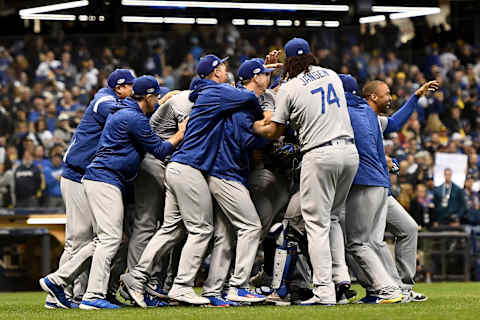
Pondering the key moments behind the Los Angeles Dodgers’ 5-1 victory over Milwaukee in Game 7 of the NLCS
Any series-deciding game – even one ultimately settled by a four-run margin as was Saturday night’s NLCS contest between the Los Angeles Dodgers and Milwaukee Brewers – has its share of decision points. Those are the moments when a manager or player must choose between options that could lead to the success – or failure – of his side’s cause.
The Dodgers-Brewers Game 7 contained several such options. (In fact following a series as replete with pitching changes and lineup switches as this one was, some have labeled it a manager’s series.)
The truth is that both Dodger manager Dave Roberts and Brewers manager Craig Counsell – as well as their players — faced critical decision points on the way to the Dodger victory. They involved not just who to start and when to pull those starters, but in what order to present their bullpen, how to deploy their defensive forces, and whether to let season-long or recent performance guide their personnel decisions.
The outcome sends the Dodgers to the World Series, where they will find a very old foe, the Boston Red Sox. The teams have met previously in a Fall Classic, but it was more than a century ago. In 1916, the Red Sox beat the Dodgers, then playing in Brooklyn, in five games.
As fans everywhere micro-analyze Game 7, this is a good time to look at the evening’s critical decision points, considering not just what the manager or player did and why, but also whether it contributed to victory … or to defeat.
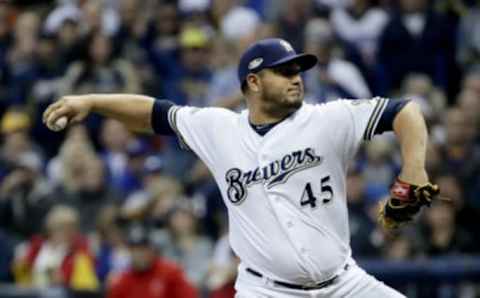
Counsell pinch hit for starter Jhoulys Chacin with two out and two runners on base in the bottom of the second inning. The pinch hitter, Jonathan Schoop, grounded out on a pitch inside off the plate – more on that later.
There are arguments on both sides of the question of whether to pull Chacin at that point. In support of Counsell’s move: the Brewers trailed by a run in a situation where a hit would tie the game or possibly give them the lead; Milwaukee’s bullpen was both deep and fresh, and Counsell obviously had more faith in his pen than in his rotation guy, having let none of them pitch past the sixth inning all series.
But there were also arguments against lifting Chacin. He was, after all, Milwaukee’s ace, coming off a 15-8 season and having beaten the Dodgers in Game 3. To lift him at that early moment sent a message that Counsell did not believe his team likely to have many offensive opportunities against Dodger starter Walker Buehler. (He turned out to be right about that, for reasons which will be discussed.)
The bottom line, though, is that Schoop made the third out, killing the Brewers’ run-scoring chance. We’ll never know what would have happened had Chacin – coming off an inning in which he allowed three solid hits including a two-run Corey Bellinger home run – had stayed in the game. We do know what happened after Counsell lifted him, and the result was not positive for Milwaukee.
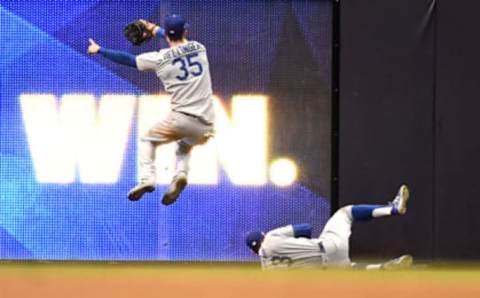
When Counsell brought in Josh Hader to start the third inning, Roberts responded by sitting down left-fielder Joc Pederson in favor of a right-handed pinch hitter, Kike Hernandez. Given that the Dodgers led at the time and Hernandez was leading off the inning, it seemed like an odd time to remove a threat of Pederson’s merit – he did after all hit 25 regular season home runs.
Hader dispatched Hernandez on three pitches, making the move look that much more puzzling. It initiated three solid innings on the mound for Milwaukee’s relief idol, who worked through the fifth, allowing just one hit and one walk before being removed for a pinch hitter.
Roberts’ move did, however, have a serendipitous long-term outcome for the Dodgers. In the bottom of the third, Hernandez went to second base and erstwhile second baseman Chris Taylor, a defensive upgrade, replaced Pederson in left.
The Dodgers still led 2-1 in the fifth when Lorenzo Cain doubled and Christian Yelich sent a line drive into the gap in left-center. Taylor sprinted over and made a diving catch that not only denied Milwaukee the game’s tying run and kept the lead run out of scoring position but ended the inning.
The Brewers never again came close to tying the game or taking the lead.
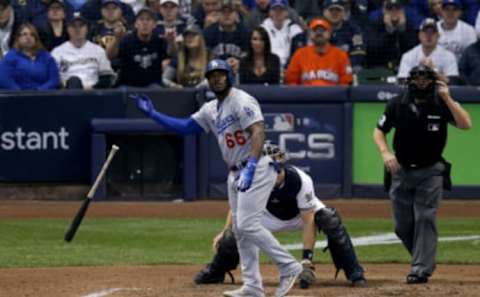
When Counsell removed Chacin for Hader starting the third, it also initiated a chain reaction of bullpen use. Eventually, Milwaukee would employ five relievers – Hader, Xavier Cedeno, Jeremy Jeffress, Corey Knebel and Brandon Woodruff.
The problem with that level of commitment to a bullpen lies in the potential for one of the five – and it only takes one – to have a bad night. For much of the post-season, that bad night has belonged to the Brewers’ closer, Jeffress. During the regular season, he had an 8-1 record, 15 saves and a 1.29 ERA. During post-season play, however, he had allowed four runs and 13 hits in eight innings of work.
In other words, by the middle of Saturday’s game 7, Counsell should have been expected to wonder which Jeffress he was summoning, the regular-season star or his post-season evil twin.
The post-season twin showed up, served up a single to Justin Turner and a three-run bomb to Yasiel Puig, and removed all further suspense from the outcome.
Jeffress’ failure illustrated the essential problem with reliever-based strategies, the unsupportable assumption that the guy you are bringing in will always perform up to the ability level you expect based on his season-long work. There is only one problem with this logic: the guy you’re bringing in is human.
Jeremy Jeffress had a great season, but a bad couple of weeks. Counsell’s failure to react to that changing dynamic may have cost his team a World Series spot.
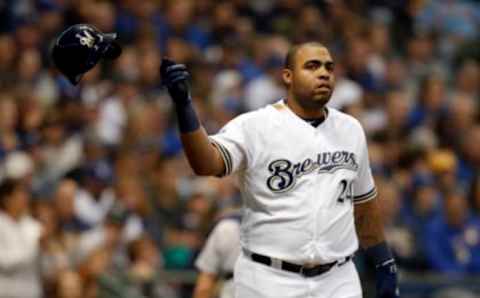
All night, but particularly once Puig homered, Brewers hitters responded with an offensive approach that looked something close to panic-stricken. On a dozen different Brewer at bats, the action pitch involved a swing at a ball that was outside the strike zone. Guess how many hits the Brewers collected from those dozen undisciplined at bats?
If you guessed zero, you are correct.
This tendency showed itself as early as the second inning. Leading off, Jesus Aguilar chased an eye-high fastball from Buehler on a 3-2 count and struck out. Had he merely taken the pitch, the bases would have been full with just one out a few moments later when Schoop came up. Instead there were two out and the tying and go-ahead runs on first and second. Like Aguilar, Schoop went outside the zone to flail weakly at an inside fastball that he nubbed to Turner for the final out.
In the fourth inning, with the tying run in scoring position, Aguilar and catcher Erik Kratz both struck out chasing bad pitches. Aguilar a third time fanned on a bad pitch in the sixth, by which time the Brewer hitters – trailing by four runs – appeared desperate. Of their nine outs made between the sixth and eighth innings, six came on pitches outside the strike zone; four of those were strikeouts.
Yelich and Braun, Milwaukee’s two best hitters all season, both fanned in the eighth on pitches that would have been called balls.
Ted Williams’ first rule of hitting was to get a good pitch to hit. The Brewers often didn’t.
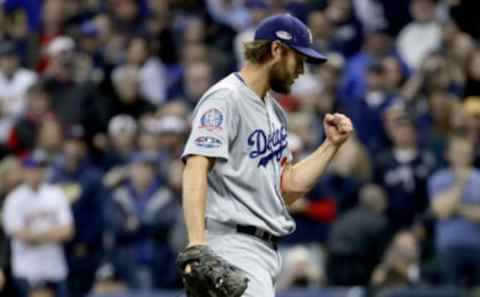
Los Angeles showed better plate discipline, recording only five outs on pitches outside the strike zone and collecting two hits on wayward offerings…one of them being Puig’s three-run homer.
More from Call to the Pen
- Philadelphia Phillies, ready for a stretch run, bomb St. Louis Cardinals
- Philadelphia Phillies: The 4 players on the franchise’s Mount Rushmore
- Boston Red Sox fans should be upset over Mookie Betts’ comment
- Analyzing the Boston Red Sox trade for Dave Henderson and Spike Owen
- 2023 MLB postseason likely to have a strange look without Yankees, Red Sox, Cardinals
But the Dodgers true key lay in Roberts’ use of his bullpen, notably in his decision not to go to it until he had to. That moment came in the fifth when, with two out and Lorenzo Cain at second – Roberts called left-hander Julio Urias to deal with Christian Yelich. That was the ball Yelich plastered toward the gap in left-center that made a defensive hero of Taylor.
But having nursed nearly five full innings from Buehler – and soon to be holding a four-run lead – Roberts faced less pressure while possessing more leeway in the use of his reserves. That wiggle room allowed him for the most to bypass his middle relief corps, needing just that single out from Urias and 1.2 innings from Ryan Madson. Instead, Roberts was able to apply his aces where they could actually shut the door. Closer Kenley Jansen pitched in the seventh and eighth, and starter Clayton Kershaw, mopped up the ninth.
Puig making postseason history. dark. Next
Their work made easier by the Milwaukee hitters’ anxiety attacks, Jansen and Kershaw combined to retire all seven hitters they faced without incident.